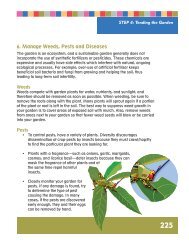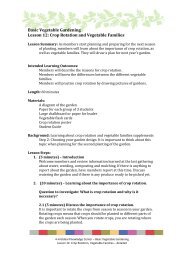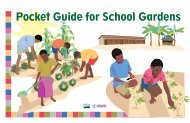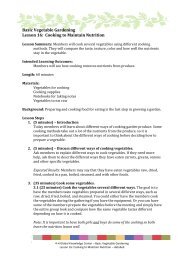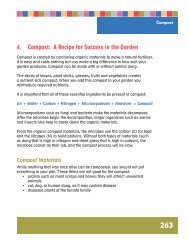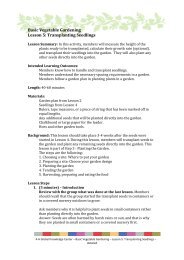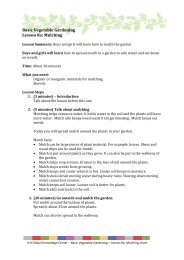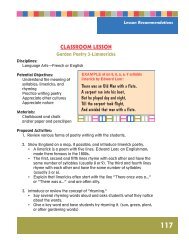Lesson 13 â Harvesting Produce - 4-H Africa Knowledge Center.
Lesson 13 â Harvesting Produce - 4-H Africa Knowledge Center.
Lesson 13 â Harvesting Produce - 4-H Africa Knowledge Center.
You also want an ePaper? Increase the reach of your titles
YUMPU automatically turns print PDFs into web optimized ePapers that Google loves.
Basic Vegetable Gardening<br />
<strong>Lesson</strong> <strong>13</strong>: <strong>Harvesting</strong><br />
<strong>Lesson</strong> Summary: Members learn how and when to harvest produce from the garden.<br />
Members will:<br />
know the signs that produce is ready to be harvested.<br />
use correct ways to harvest produce.<br />
Time: 40 minutes<br />
What you need:<br />
Notebook or paper for notes<br />
Pocket Guide from set of garden materials<br />
Note: You can teach this lesson more than one time during the garden season.<br />
Vegetables will be ready to harvest at different times. Seeds will also be ready to save a<br />
different times.<br />
<strong>Lesson</strong> Steps<br />
1. (2 minutes) – Introduction<br />
2. (5 minutes) – Talk about harvesting fruits and vegetables.<br />
Harvest means to pick the fruit or vegetable from the plant. Some produce in the<br />
group’s garden may be ready to harvest.<br />
It is important to pick fruit at the right time so that it tastes good and has a high<br />
level of nutrition.<br />
Ripe produce is very easy to take off of the plant.<br />
3. (15 minutes) Go out to the garden and look at some of the plants.<br />
Look at the plants and see if they are ready to harvest.<br />
Use the Pocket Guide to discuss when the vegetables are ready to harvest.<br />
If possible, pick one ripe vegetable, one over-ripe vegetable, and one under-ripe<br />
vegetable. Wash and cut them up. Have the members taste the difference.<br />
Some people let vegetables get too mature before harvesting. Why do you think<br />
they do that?<br />
4. (10 minutes) Talk about saving seeds for next year.<br />
4.1 Compare the advantages (good) and disadvantages (bad) of saving<br />
seeds or buying seeds for future plantings. Have members make a chart in<br />
their notebooks.<br />
4-H Global <strong>Knowledge</strong> <strong>Center</strong> – Basic Vegetable Gardening – <strong>Lesson</strong> <strong>13</strong>: <strong>Harvesting</strong> - short
Saving seeds *<br />
Advantages No cost<br />
Grow well in local<br />
climate<br />
Disadvantages May have disease or not<br />
be resistant to diseases<br />
Poor germination rate<br />
Lower yield<br />
Need proper storage<br />
Buying seeds<br />
Developed for local climate<br />
Higher yield<br />
Resistant to many diseases<br />
High germination rate<br />
Cost more<br />
Hybrids cannot be saved<br />
(usually sterile)<br />
* Saving seeds only works with open-pollinated seeds. They are from plants that<br />
self-pollinate or are pollinated naturally by wind or insects.<br />
What seeds are best saved? Which seeds are better to buy?<br />
4.2 If you decide to save seeds, follow these steps:<br />
1. Before you harvest the plants, choose the best, big fruits and vegetables to<br />
save for seeds.<br />
2. When you choose the fruit that you will use to save seeds, mark it with a<br />
stick. Do not harvest it for food.<br />
3. Save tomato and cucumber seeds by separating the tomato seeds from the<br />
cucumber seeds. Put them in water. Then put them in the sun for a few<br />
days. Fungus will form. It will help keep your seeds and prepare them for<br />
new growth. After three or four days, rinse your seeds and dry them. Save<br />
them for the next planting.<br />
5. (5 minutes) - Review<br />
Ask the members these questions:<br />
How can you tell if a fruit or vegetable is ready to harvest?<br />
Answer: It comes off from the plant easily.<br />
What are some advantages of saving seeds? What are some advantages of<br />
buying seeds?<br />
6. (1 minute) - Close<br />
Tell the members when the next meeting will be and what the topic will be.<br />
Keep all of your notes in your notebook.<br />
An example of harvesting information from the Pocket Guide to School Gardens.<br />
4-H Global <strong>Knowledge</strong> <strong>Center</strong> – Basic Vegetable Gardening – <strong>Lesson</strong> <strong>13</strong>: <strong>Harvesting</strong> - short
4-H Global <strong>Knowledge</strong> <strong>Center</strong> – Basic Vegetable Gardening – <strong>Lesson</strong> <strong>13</strong>: <strong>Harvesting</strong> - short



